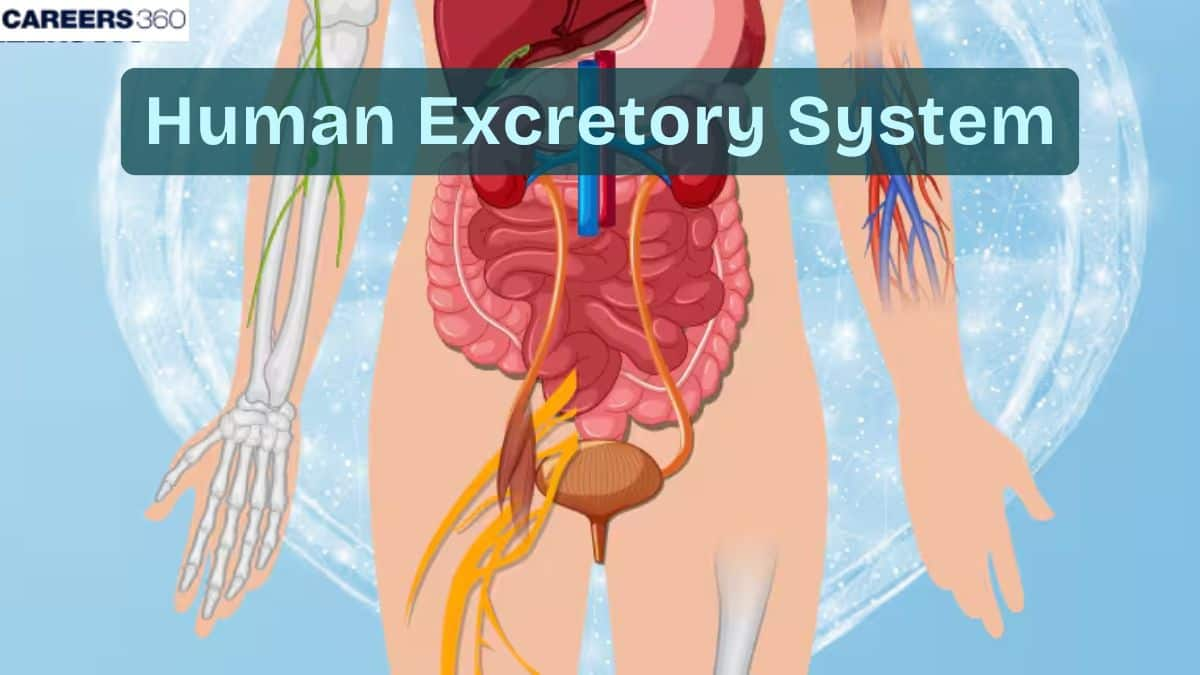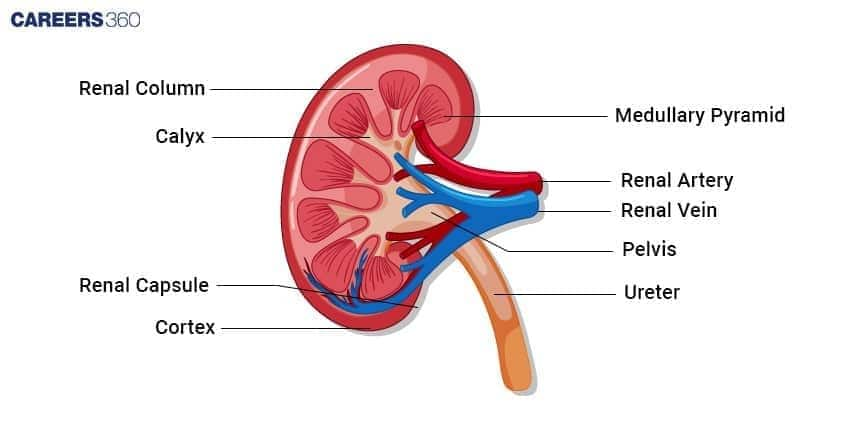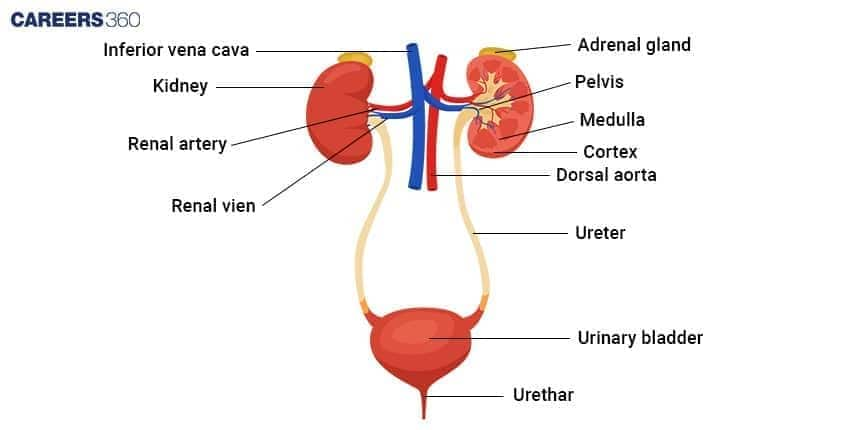Human Excretory system: Definition, Diagram, Function
The human excretory system removes nitrogenous wastes, excess salts, toxins, and water to maintain internal chemical stability (homeostasis). Kidneys filter blood through nearly one million nephrons per kidney, forming urine via filtration, reabsorption, and secretion. This guide covers kidney structure, nephron anatomy, urine formation, hormonal regulation, JGA, disorders, diagrams, FAQs, and NEET MCQs.
This Story also Contains
- What Is the Human Excretory System? (Definition & Importance)
- Major Organs of the Human Excretory System
- Mechanism of Urine Formation (Three Steps)
- Regulation of Kidney Function
- Disorders of the Excretory System
- Human Excretory System NEET MCQs (With Answers & Explanations)
- Recommended Video On ‘Human Excretory System’

What Is the Human Excretory System? (Definition & Importance)
The human excretory system is an important physiological system, responsible for carrying out an activity of the disposal of waste products and excess substances from the blood. This helps to keep the constancy of the internal environment of the body. This consists of four organs: the kidneys, the ureters, the urinary bladder, and the urethra, all functioning together in blood filtration and the resulting urine production and its elimination from the body.
Excretion is critical to homeostasis since it restores the conditions for the body's interior. Conditions for the volume and composition of body fluids, which in turn establishes blood pressure, electrolyte balance, and acid-base balance are thus maintained with the exact conditions needed to function at the cellular and consequently the health levels.
Major Organs of the Human Excretory System
The human excretory system contains important parts with varied excretory functions.
Kidneys (Primary Excretory Organ)
The kidneys are complex organs with several distinct structures, each serving a specific function in the filtration and excretion process:
Renal Capsule
Tough, fibrous outer layer that serves to protect the kidney.
Cortex
The outer region of the kidney contains glomeruli and convoluted tubules.
Site of ultrafiltration and initial stages of urine formation.
Medulla
The inner region consists of renal pyramids and renal columns.
It contains the loops of Henle and collecting ducts.
Renal Pyramids
Triangular-shaped structures within the medulla.
It contains nephron loops and collecting ducts that transport urine to the calyces.
Renal Columns
Bands of cortical tissue that separate the renal pyramids.
Provide support for the passage of blood vessels through the kidney.
Nephrons
The microscopic functional units of the kidney. Each nephron is made up of a renal corpuscle and renal tubule.
There are approximately 1 million nephrons per kidney.
Renal Corpuscle
It is made up of glomerulus and Bowman's capsule and is the first site of blood filtration.
Glomerulus: A network of capillaries in which the blood filtration takes place. It is enclosed by Bowman's capsule.
Bowman's Capsule: A cup-like structure that surrounds the glomerulus, collects the filtrate from the blood.
Renal Tubule
Proximal Convoluted Tubule (PCT): The first segment is for the renal tubule, reabsorbs water, ions and nutrients back from the filtrate.
Loop of Henle: The U-shaped part of the renal tubule extends into the medulla. It is responsible for concentrating urine by reabsorbing water and salt.
Distal Convoluted Tubule (DCT): The last segment of the renal tubule is before the collecting duct which helps in further reabsorption and secretion of ions.
Collecting Ducts: Ducts receive urine from several nephrons and transport urine to the renal pelvis.
Renal Pelvis
A funnel-shaped cavity collects urine from collecting ducts.
Channels urine into the ureter.
Renal Artery & Vein
Supplies the kidney with blood.
Branches further into smaller arterioles, which service the glomerulus
Drains into the inferior vena cava while it conveys deoxygenated blood from the kidney.

Ureters
Muscular tubes that connect kidneys to the urinary bladder.
The conveyance of urine from the kidneys to the bladder.
Urinary Bladder
A hollow, muscular organ located in the pelvis.
Stores urine until it is eliminated.
Urethra
Tube extending from the bladder to the outside of the body.
Involved in the elimination of urine.

Mechanism of Urine Formation (Three Steps)
The net process of urine formation comprises filtration, reabsorption, and secretion. This occurs in the kidneys.
Glomerular Filtration
Blood enters the glomerulus water and solutes get filtered into Bowman's capsule.
Filtration is driven by blood pressure.
Tubular Reabsorption
Essential substances like glucose, amino acids, and ions get reabsorbed into the blood.
Basically in the proximal convoluted tubule.
Plays a significant role in the reabsorption process of important nutrients and water balance.
Tubular Secretion
The secretion of waste products hydrogen ions, potassium, and some drugs into the tubule.
This contributes to excess unwanted compounds that are eliminated from the blood.
Regulation of Kidney Function
The regulation of kidney functions are mainly through hormones and specific structures to maintain the overall water balance of body fluids and homeostasis.
Hormonal Control
ADH: increases the amount of water reabsorption by kidneys.
Aldosterone: increases the amount of Na+ reabsorption and K+ secretion.
ANP: decreases the amount of Na+ reabsorption and lowers blood pressure.
Mechanism of Osmoregulation
Water and Electrolyte balance to sustain osmolarity of blood.
Implores negative feedback loops and hormonal control.
Role of Juxtaglomerular Apparatus
Specialised cells near the glomerulus
Produces renin, thus regulating blood pressure and the filtration rate.
Disorders of the Excretory System
Many disorders of the excretory system, which inhibits the proper clearance of wastes and continued homeostasis.
Kidney Stones
These are caused by low fluid intake, high salt consumption, and genetics.
Symptoms include severe pain, blood in urine, and frequent urination.
Treatment are increased fluid intake, medications, and surgery.
Urinary Tract Infections (UTIs)
Caused by bacterial infection, poor hygiene, and use of a catheter.
Symptoms include painful urination, an urge to urinate frequently, and cloudy urine.
Treatment options are antibiotics and increased fluid intake.
Chronic Kidney Disease (CKD)
Stages 1 to 5, based on GFR
Caused by diabetes, blood pressure, glomerulonephritis.
Symptoms include fatigue, swelling, nausea, and decreased urine output.
Treatment options include behavioural changes, medications, dialysis, and kidney transplants.
Human Excretory System NEET MCQs (With Answers & Explanations)
Important questions asked in NEET from this topic are:
Major organs in excretory system
Regulation of kidney function
Practice Questions for NEET
Q1. With its anatomical positioning and the surrounding peritoneum, what distinct characteristic defines the retroperitoneal kidney?
Kidney of a fish
Kidney covered by Peritoneum on ventral side
Kidney covered by Peritoneum on Dorsal side
Kidney uncovered by Peritoneum on ventral Side
Correct answer: 2) Kidney covered by Peritoneum on ventral side
Explanation:
In the retroperitoneal position, the kidney is located behind the peritoneum, specifically covered by it on the ventral side. This distinguishes it from other options where the kidney is either covered by the peritoneum on the dorsal side (option 3) or not covered by the peritoneum on the ventral side (option 4). The retroperitoneal positioning of the kidney is common in mammals, including humans.
Hence, the correct answer is option 2) The Kidney is covered by the Peritoneum on the ventral side.
Q2. What is the function of the renal pelvis in the human excretory system?
To filter waste from the blood
To store urine temporarily
To transport urine from the kidneys to the bladder
To collect urine from the nephrons and direct it to the ureters
Correct answer: 4) To collect urine from the nephrons and direct it to the ureters
Explanation:
The primary purpose of the renal pelvis, a funnel-shaped organ in the centre of the kidney, is to collect urine that has been produced by the nephrons. The tiny kidney structure known as a nephron filters waste and extra water from the blood. The nephrons also create urine, which is then transported through a network of tiny tubes known as collecting ducts and excreted into the renal pelvis. The ureters, which are muscular tubes that carry urine from the kidneys to the bladder for momentary storage before eventual elimination from the body, are then directed to receive the urine by the renal pelvis.
Hence, the correct answer is option 4) To collect urine from the nephrons and direct it to the ureters.
Q3. Select the incorrect pair and write the role of organs in excretion:
Lungs - a large amount of CO2
Skin - sweat, urea, lactic acid
Sweat gland - facilitates cooling effect on body surface
None of these
Correct answer: 4) None of these
Explanation:
The skin and lungs play significant roles in excretion. Sweat glands in the skin produce sweat, a watery fluid containing NaCl, urea, lactic acid, and other substances, facilitating the removal of metabolic wastes while primarily aiding in cooling the body's surface. Sebaceous glands also contribute by eliminating certain substances through their secretions. The lungs complement this process by expelling large amounts of carbon dioxide, approximately 200 mL per minute, along with significant quantities of water vapor daily, underscoring their critical role in maintaining homeostasis and excretory balance.
Hence, the correct answer is option 4) None of these.
Also Read:
Recommended Video On ‘Human Excretory System’
Frequently Asked Questions (FAQs)
Severe back or side pain, blood in the urine, frequent/painful urination, nausea.
Drink plenty of water; eat a healthy diet; maintain good hygiene.
By GFR, chronic kidney disease is classified into five stages, in ascending order of severity, from mild (Stage 1) to kidney failure (Stage 5).